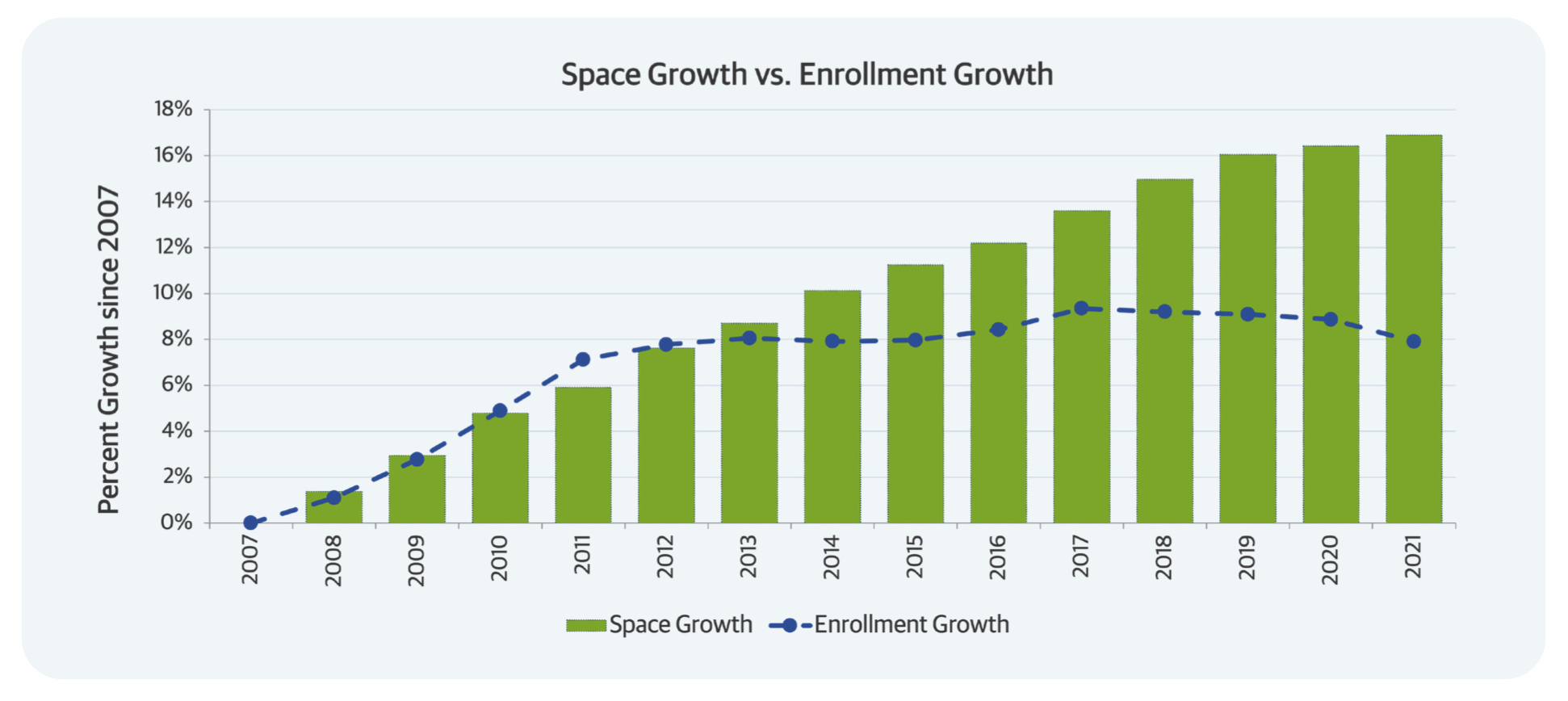Gordian released the 9th edition of the State of Facilities in Higher Education report, which confirms a growing backlog of capital needs and reveals a downturn in operating budgets. Preliminary fiscal year 2021 data shows a year-over-year investment reduction of 19 percent, as major capital projects were slowed or halted, and recurring stewardship expenditures dipped further.
“Across higher education, focused facilities stewardship and capital planning are more critical than ever. The findings from this year’s report further invigorate our mission to help institutions prioritize investments and drive meaningful outcomes within their communities,” says Mark Schiff, President of Gordian.
Throughout the report, Gordian’s database research and its expert insights affirm the following trends that are shifting the higher education landscape:
- Preliminary data warns that the facilities investment shortfall to anticipated demands is approaching 40 percent, accelerating the deferral of projects necessary to steward the campus.
- Gordian’s database shows an average need of $105/GSF at the end of FY20.
- 30 percent of buildings in the Gordian database are in the 10-25-year age group, and the major systems of many of them will soon reach the end of their lives. A convergence of anticipated lifecycle needs for a large portfolio of campus facilities and the well-documented enrollment cliff on the horizon is expected to bear down on higher ed over the next 10-15 years.
- Operating budgets have plunged 9 percent since FY19, and preliminary data for FY21 shows an average workforce reduction of 8 percent.
- Survey results through a partnership with APPA revealed a silver lining — 56 percent of facilities leaders indicated they have greater influence on campus since the pandemic.
This year, data from Gordian’s database of 52,000+ higher ed facilities representing about 300 campuses across North America shows the continuation of familiar trends and some expected changes in response to the pandemic environment. To complement our facilities data with perspectives from the frontline, we partnered with APPA to survey nearly 700 facilities leaders concerning the current pressures they are under and captured the responses in this report.

“Facilities leaders continue to talk about the extent to which their voice has been heard and continues to be heard,” said Pete Zuraw, Vice President of Market Strategy and Development for Gordian. “We want to keep championing your use of that voice to make a difference on your campuses.”
Facilities strategies are at the forefront of the industry’s race to confront its greatest challenge in generations. The report also points to successful case studies and solution frameworks to help institutions plan coherently, leverage technology and invest creatively. These examples and best practices can be fundamental to helping institutions unified around change adapt to today’s problems and create a richer and more viable future.
Download the 9th edition of the State of Facilities in Higher Education report (short registration required).
Related Stories
| Oct 9, 2014
Regulations, demand will accelerate revenue from zero energy buildings, according to study
A new study by Navigant Research projects that public- and private-sector efforts to lower the carbon footprint of new and renovated commercial and residential structures will boost the annual revenue generated by commercial and residential zero energy buildings over the next 20 years by 122.5%, to $1.4 trillion.
| Oct 9, 2014
Beyond the bench: Meet the modern laboratory facility
Like office workers escaping from the perceived confines of cubicles, today’s scientists have been freed from the trappings of the typical lab bench, writes Perkins+Will's Bill Harris.
| Sep 24, 2014
Architecture billings see continued strength, led by institutional sector
On the heels of recording its strongest pace of growth since 2007, there continues to be an increasing level of demand for design services signaled in the latest Architecture Billings Index.
| Sep 22, 2014
4 keys to effective post-occupancy evaluations
Perkins+Will's Janice Barnes covers the four steps that designers should take to create POEs that provide design direction and measure design effectiveness.
| Sep 22, 2014
Sound selections: 12 great choices for ceilings and acoustical walls
From metal mesh panels to concealed-suspension ceilings, here's our roundup of the latest acoustical ceiling and wall products.
| Sep 17, 2014
New hub on campus: Where learning is headed and what it means for the college campus
It seems that the most recent buildings to pop up on college campuses are trying to do more than just support academics. They are acting as hubs for all sorts of on-campus activities, writes Gensler's David Broz.
| Sep 9, 2014
Using Facebook to transform workplace design
As part of our ongoing studies of how building design influences human behavior in today’s social media-driven world, HOK’s workplace strategists had an idea: Leverage the power of social media to collect data about how people feel about their workplaces and the type of spaces they need to succeed.
| Sep 7, 2014
Ranked: Top state government sector AEC firms [2014 Giants 300 Report]
PCL Construction, Stantec, and AECOM head BD+C's rankings of the nation's largest state government design and construction firms, as reported in the 2014 Giants 300 Report.
| Sep 7, 2014
Behind the scenes of integrated project delivery — successful tools and applications
The underlying variables and tools used to manage collaboration between teams is ultimately the driving for success with IPD, writes CBRE Healthcare's Megan Donham.
| Sep 3, 2014
New designation launched to streamline LEED review process
The LEED Proven Provider designation is designed to minimize the need for additional work during the project review process.
















